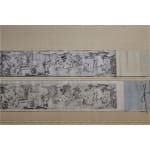Xu Yanghong’s One Hundred Children and Its Copy by Tani Bunchō
One Hundred Children
Xu Yanghong
Color on paper, handscroll
With box authentication and titled by Watanabe Gentai (1749–1822)
Seals: Jo Yoko in; Kokatsu Ryoun
29.8 x 526 cm
31 x 686.5 cm (overall)
Provenance
Collection of Watanabe Gentai
Copy of Xu Yanghong's One Hundred Children
Tani Buncho (1763−1840)
Color on paper, handscroll
Dated Bunka 1 (1804)
With box authentication and titled by Satake Eiryo (1933)
Seals: Tani Buncho in; Tani shi Buncho
30.1 x 528 cm
35.2 x 609.5 cm (overall)
Xu Yanghong
Color on paper, handscroll
With box authentication and titled by Watanabe Gentai (1749–1822)
Seals: Jo Yoko in; Kokatsu Ryoun
29.8 x 526 cm
31 x 686.5 cm (overall)
Provenance
Collection of Watanabe Gentai
Copy of Xu Yanghong's One Hundred Children
Tani Buncho (1763−1840)
Color on paper, handscroll
Dated Bunka 1 (1804)
With box authentication and titled by Satake Eiryo (1933)
Seals: Tani Buncho in; Tani shi Buncho
30.1 x 528 cm
35.2 x 609.5 cm (overall)
Further images
-
(View a larger image of thumbnail 1
)

-
(View a larger image of thumbnail 2
)

-
(View a larger image of thumbnail 3
)

-
(View a larger image of thumbnail 4
)

-
(View a larger image of thumbnail 5
)

-
(View a larger image of thumbnail 6
)

-
(View a larger image of thumbnail 7
)

-
(View a larger image of thumbnail 8
)

The present two scrolls—the original Chinese source and its sophisticated Japanese copy—having been handed down separately, miraculously reunited at our gallery in 2012.
We at first obtained the Buncho scroll in 2007, and immediately inferred that Buncho had copied a Ming or Qing scroll that was in the possession of his teacher Watanabe Gentai. Representations of fifteen boys in the Buncho scroll are found identical to those in a painting included in Rinrokugokan, an anthology of copies of paintings and inscriptions possibly published in 1805. Executed by Tokyu, the second son of Gentai, illustrations in Rinrokugokan are known to be partial copies of Ming or Qing paintings owned by the Watanabe family.
It was not until five years later that we acquired the Xu scroll and ascertained that it is the original work of the Buncho scroll, which belonged to Gentai. The scroll bears seals of Gentai and the inscription reads, “Gentai-koji chinzo” (Treasured by Layman Gentai). Gentai wrote on the lid of the box: “A Hundred Children Scroll painted by Xu Yanghong.” The Chinese painter, probably active in the early Qing period, has not been identified. Gentai must have taken the name of the painter from a seal stamped at the end of the scroll.
On the lid of the box of the Buncho scroll, Satake Eiryo wrote that Buncho imitated the style of Kitayama Kangan (1767–1801). This indicates that Eiryo might not be aware of the Xu scroll, but knew of a copy by Kangan.
Tani Buncho (painter; 1763−1840)
Edo-born literati painter in the late Edo period. Since his youth, Buncho had been interested in practicing various painting techniques, and later established a new style that integrated those of the Chinese Yuan, Ming, and Qing paintings, the Kano and Tosa Schools, and literati painting. Recognized as a prominent figure in the Edo literati painting scene. His disciples include Watanabe Kazan and Tachihara Kyosho among many others.
We at first obtained the Buncho scroll in 2007, and immediately inferred that Buncho had copied a Ming or Qing scroll that was in the possession of his teacher Watanabe Gentai. Representations of fifteen boys in the Buncho scroll are found identical to those in a painting included in Rinrokugokan, an anthology of copies of paintings and inscriptions possibly published in 1805. Executed by Tokyu, the second son of Gentai, illustrations in Rinrokugokan are known to be partial copies of Ming or Qing paintings owned by the Watanabe family.
It was not until five years later that we acquired the Xu scroll and ascertained that it is the original work of the Buncho scroll, which belonged to Gentai. The scroll bears seals of Gentai and the inscription reads, “Gentai-koji chinzo” (Treasured by Layman Gentai). Gentai wrote on the lid of the box: “A Hundred Children Scroll painted by Xu Yanghong.” The Chinese painter, probably active in the early Qing period, has not been identified. Gentai must have taken the name of the painter from a seal stamped at the end of the scroll.
On the lid of the box of the Buncho scroll, Satake Eiryo wrote that Buncho imitated the style of Kitayama Kangan (1767–1801). This indicates that Eiryo might not be aware of the Xu scroll, but knew of a copy by Kangan.
Tani Buncho (painter; 1763−1840)
Edo-born literati painter in the late Edo period. Since his youth, Buncho had been interested in practicing various painting techniques, and later established a new style that integrated those of the Chinese Yuan, Ming, and Qing paintings, the Kano and Tosa Schools, and literati painting. Recognized as a prominent figure in the Edo literati painting scene. His disciples include Watanabe Kazan and Tachihara Kyosho among many others.
342
of
342







